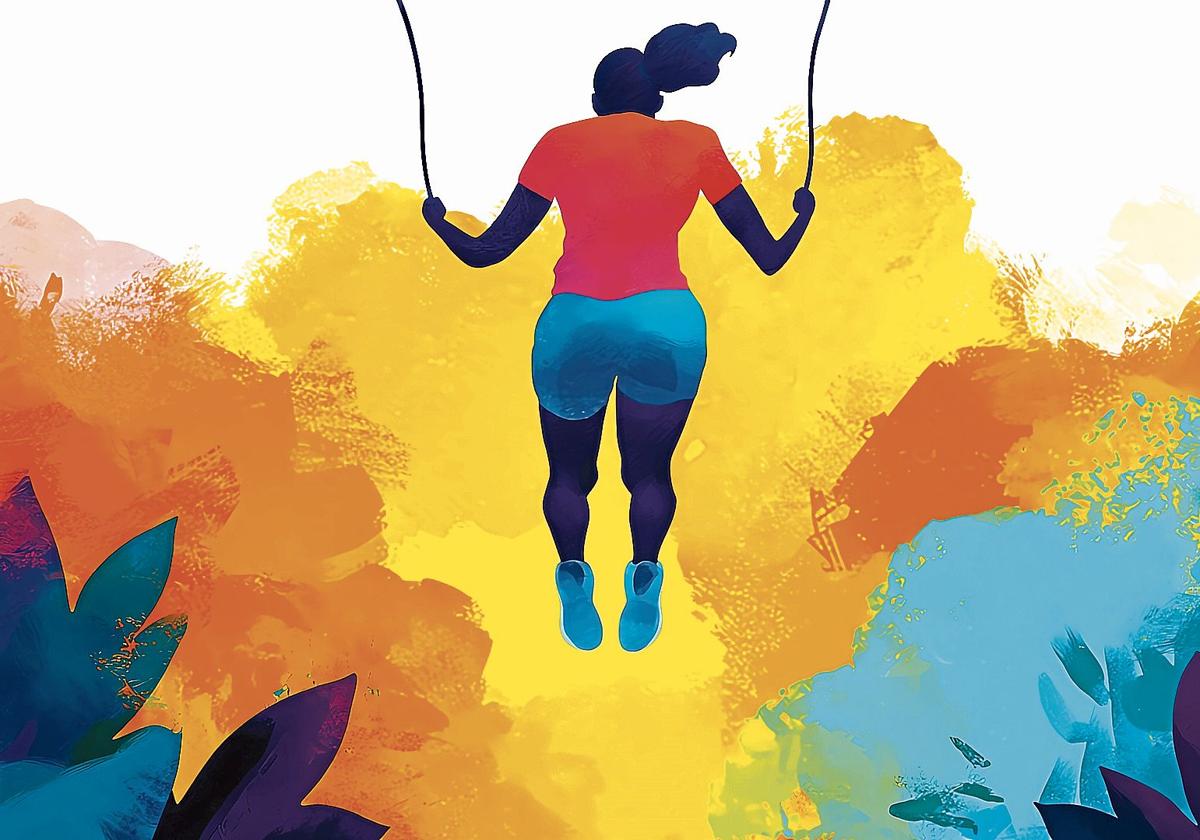The 'miracle' benefits of rope skipping for 10 minutes daily
Few exercise routines are as effective at keeping us in shape for such minimal time and effort
Do you only have ten minutes a day for some exercise? Then skip with a rope! This children's playtime activity is so much more than that and is recommended for those who want to exercise quickly, safely and without having to go to the gym. "It improves aerobic capacity in a similar way to jogging for 30 minutes a day," just one of several benefits mentioned by Marcos Vázquez, creator of the popular blog 'Fitness revolucionario'. He refers to a study conducted with 92 Harvard students, divided into two groups: one group ran for half an hour and the other did skipping for ten minutes. The former spent twice as much time exercising as the latter but, after six weeks, the benefits seen in both groups were the same.
Enrique Sainz de Murieta, member of the working group on obesity and sarcopenia (age-related muscle loss) within the Spanish Society of Rehabilitation and Physical Medicine (Sermef), confirms that rope-skipping is a sport with many virtues. Firstly, it tends to be addictive because it is a short workout: "You can start by jumping for just 10 to 15 seconds, then resting for 45 to 60 seconds between sets."
Here's how to do it right
Head: look straight ahead, not down
Upperbody: upright, knees slightly flexed (not locked)
Elbows: keep close to your sides
Wrists: use your wrists to swing the rope, not your arms
Feet: use the balls of your feet to jump and land. It's enough to jump four or five centimetres off the floor. As for footwear - best if not too padded
An effective fat burner
Evidence shows that skipping "raises energy expenditure in a short time, promotes the loss of visceral fat and improves metabolic profile", says Vázquez, adding that: "According to several studies, a 70-kilo person exercising at a rate of one jump per second would burn more than 100 calories in ten minutes." That's a lot compared to the calories expended with other exercises. "Walking for an hour would involve an expenditure of 300 calories, swimming 550, running 600 and cycling 700," says the blogger.
Strengthens bones
Although it may initially come as a shock to our bodies, "bones need impact to get stronger," says Marcos Vázquez. So, in that sense, skipping provides that impact on a small scale. "By landing on the balls of your feet, you take advantage of your body's natural cushioning, avoiding the wear and tear caused by constantly landing on your heels, as many runners do." Those who skip, as well as being fit, are relatively safe from injury "as it's an exercise with less impact and joint stress than running, for example." For this reason, says Dr Sainz de Murieta, "it is suitable for people with joint problems, especially in the knees, spine or ankles."
A whole body workout
When skipping, we focus on the feet, but it works so much more of the body. "It strengthens the legs, but also the arms, shoulders and other upper body muscles. It's a complete workout," says Vázquez. The SERMEF expert adds: "It activates large muscle groups, improves muscular endurance, strength and functional power."
For 'super athletes' only?
Far from it. "It increases heart rate without moving from the spot, ideal for sedentary people or those with a low tolerance to exercise," says Sainz de Murieta. In fact, he recommends it for people who are obese. "If your obesity is mild or moderate, you should exercise at a pace of between 10 and 30 seconds per set and complete three to five rounds, with a break of between 30 and 60 seconds between sets, two or three times a week."
Improves balance
Beyond toning muscles and burning fat, skipping has additional benefits in terms of balance and coordination. "It forces you to synchronise a number of different muscles, improving the precision of your movements, proprioception [the body's own internal sense of position, movement and force] and overall coordination," says Vázquez. He refers to a study published in the Journal of Sports Science and Medicine in which 24 pre-adolescent footballers underwent two types of training: some did rope jumps at the start of training, while the others only did football-specific exercises and no skipping rope. After eight weeks, their motor control and balance were assessed and it was shown that the group that had included skipping in their routine had clearly improved both aspects.
Seven exercises in one
The variety of jumping moves you can do while skipping makes it a very versatile exercise that is easy to adapt to each individual's training needs. Marcos Vázquez lists some possibilities: jumping with high knees, bringing the heels to the glutes, jumping with one leg, sprinting on the spot while alternating both legs, jumping forward, jumping with legs open then closed, crossing the rope or a double twist jump, something that requires you to turn the rope faster and jump higher so that the rope passes under your feet twice with each jump. Changing the exercise also has a plus: it makes the workout more entertaining and tests your skills.
Impact, the arch enemy of the pelvic floor
The highly beneficial exercise of skipping is not for everyone. "Impact sports such as skipping or running aren't good for women because they aren't the best for the pelvic floor. Even less so when there are risk factors such as several pregnancies or obesity," states Daniel Paz, gynaecologist at Vithas Vitoria Hospital. Along the same lines, the rehabilitation doctor Enrique Sainz de Murieta (Sermef) points out that "rope skipping is a high-demand exercise that involves a significant amount of intra-abdominal pressure, which can exacerbate symptoms of pelvic floor dysfunction, such as urinary incontinence or prolapse, if it is not performed with proper deep core muscle activation."


Comentar es una ventaja exclusiva para registrados
¿Ya eres registrado?
Inicia sesiónNecesitas ser suscriptor para poder responder.
Necesitas ser suscriptor para poder votar.